
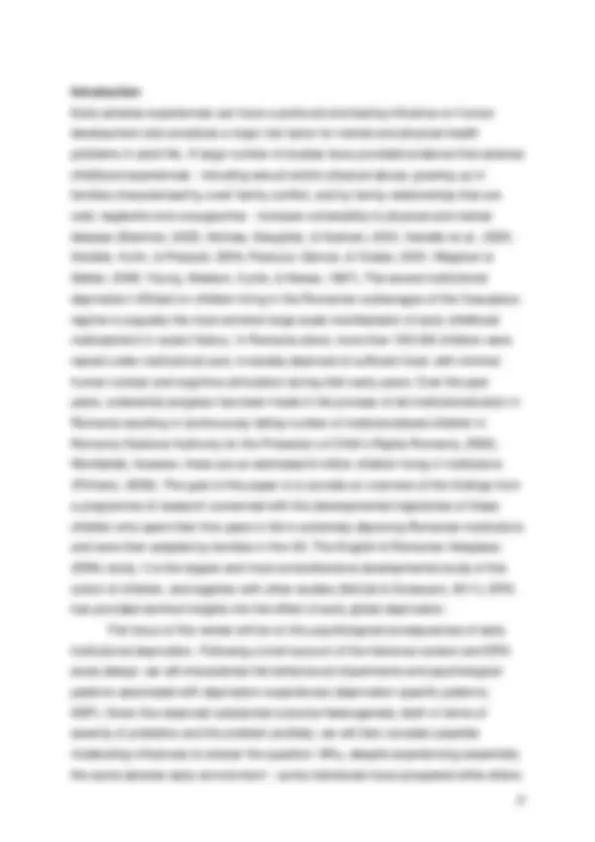
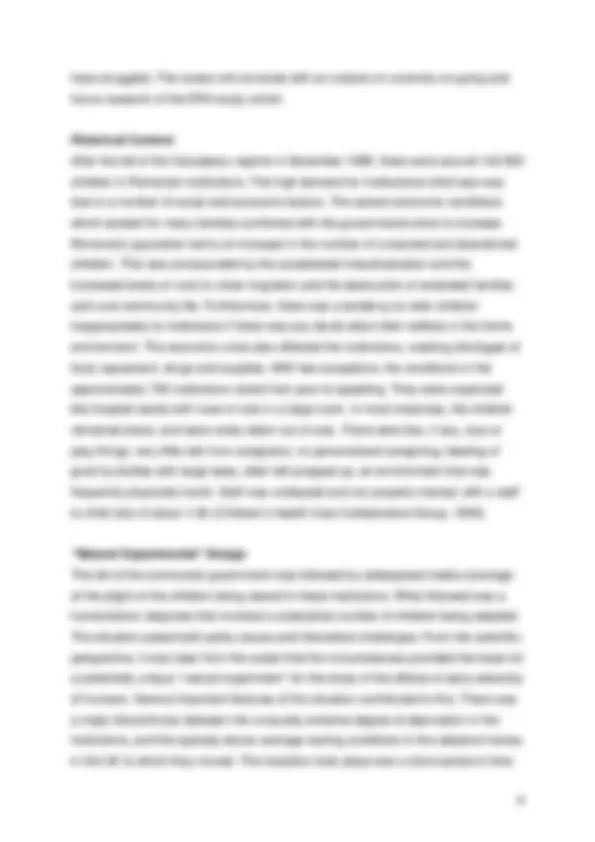

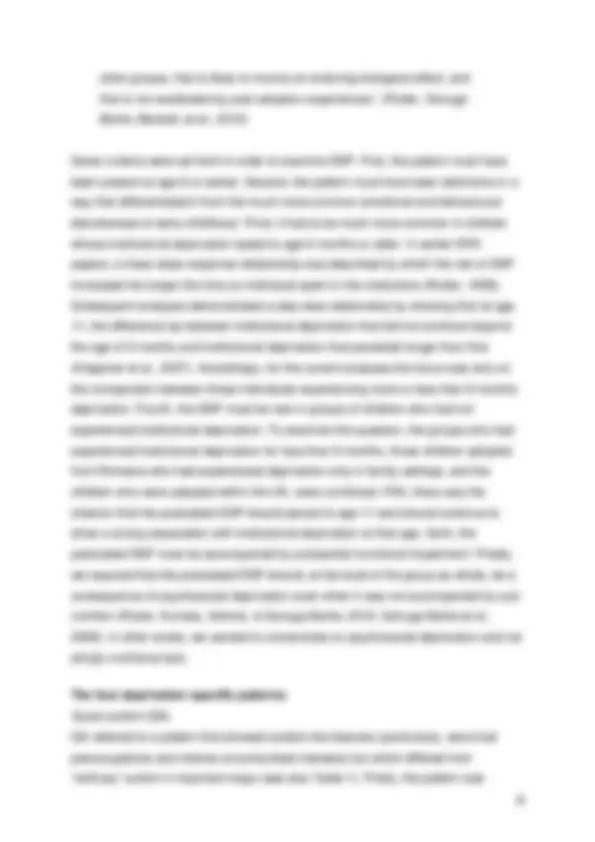
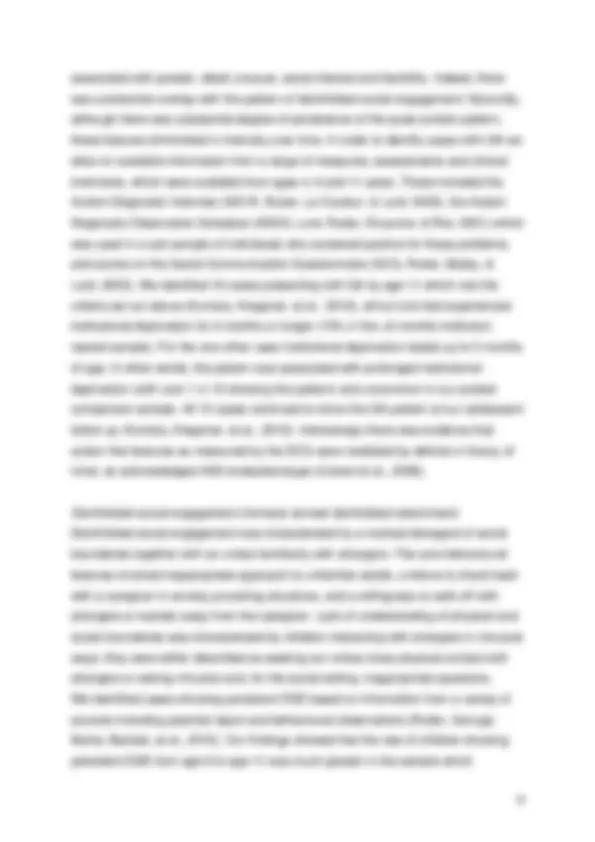
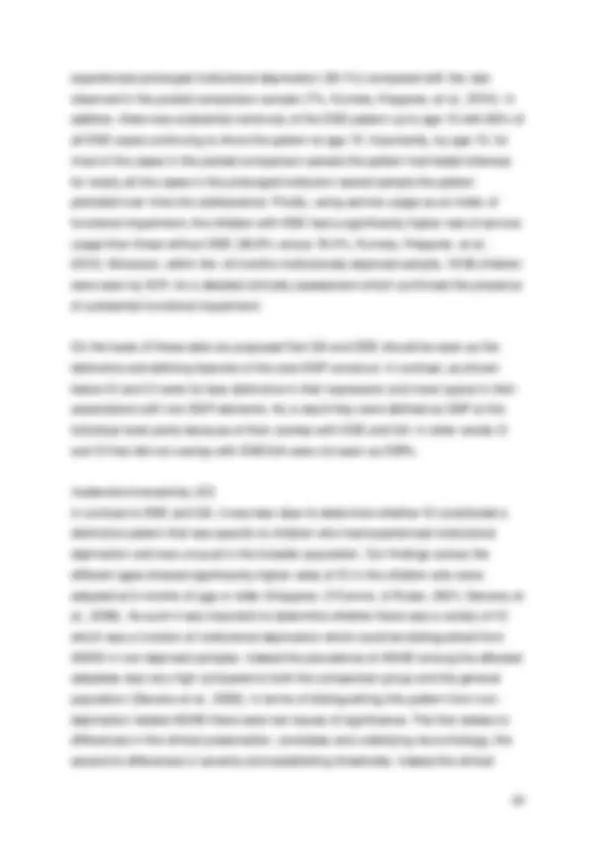
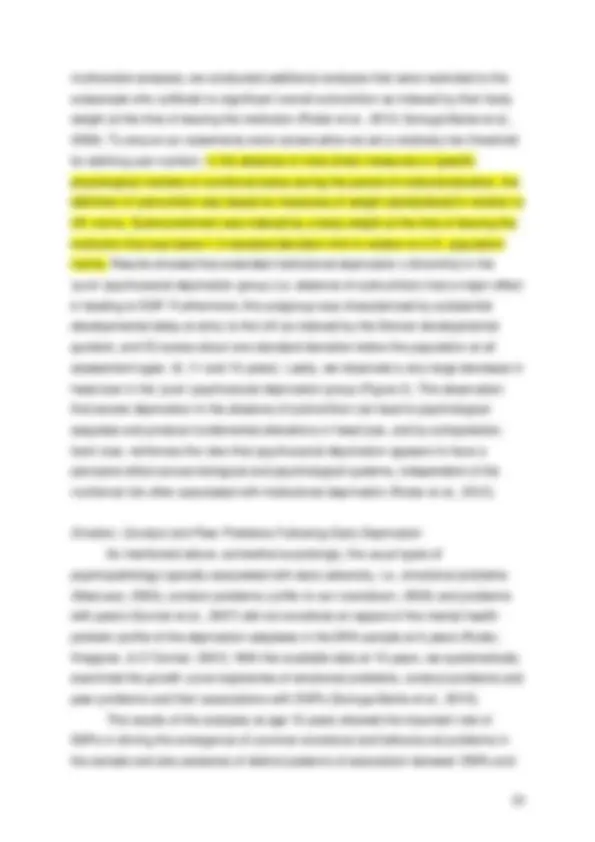
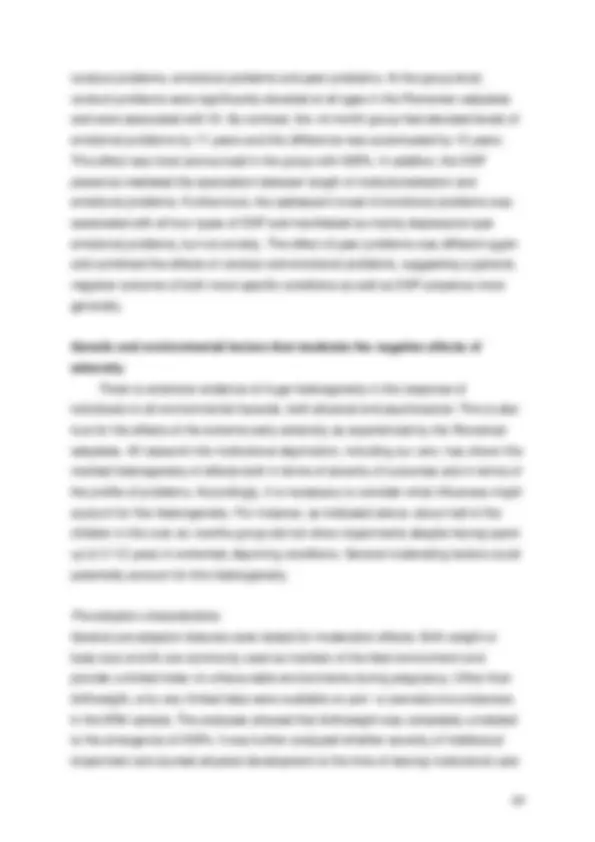
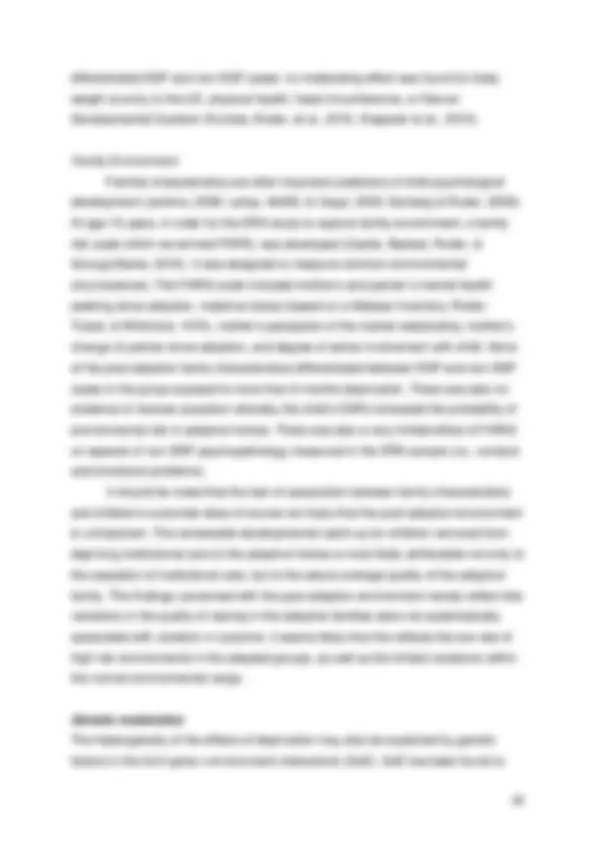
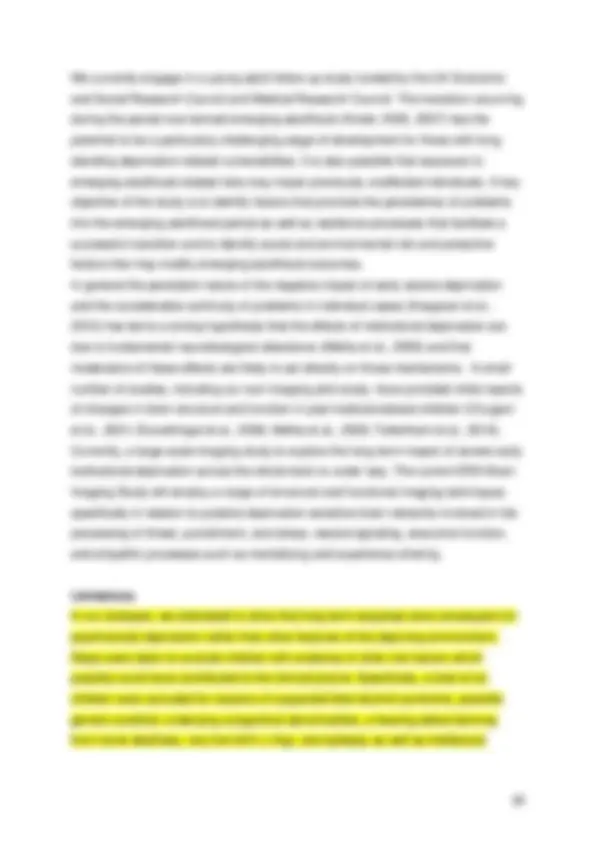










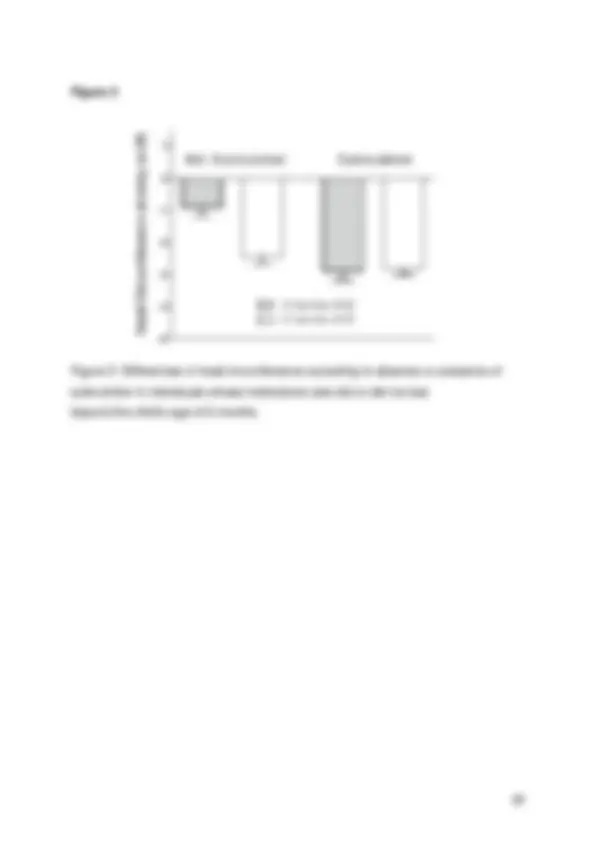
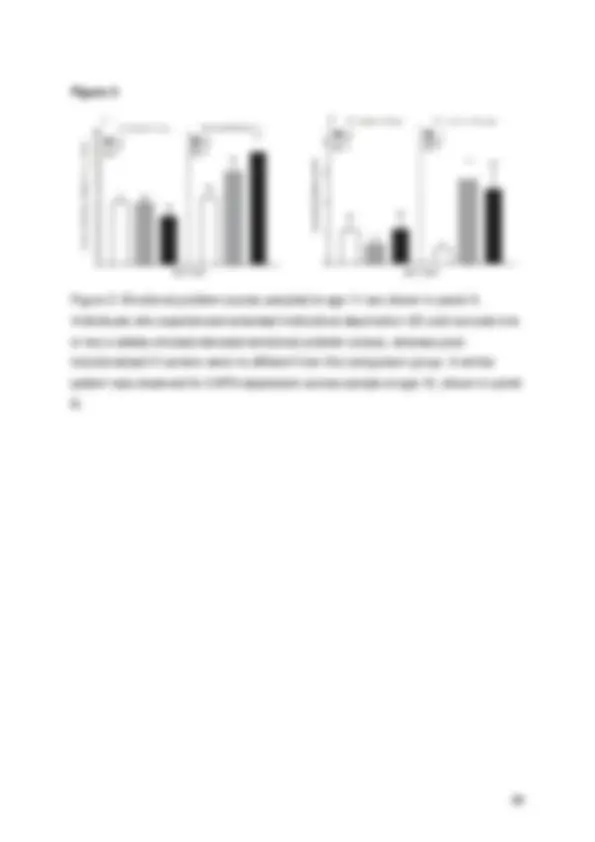
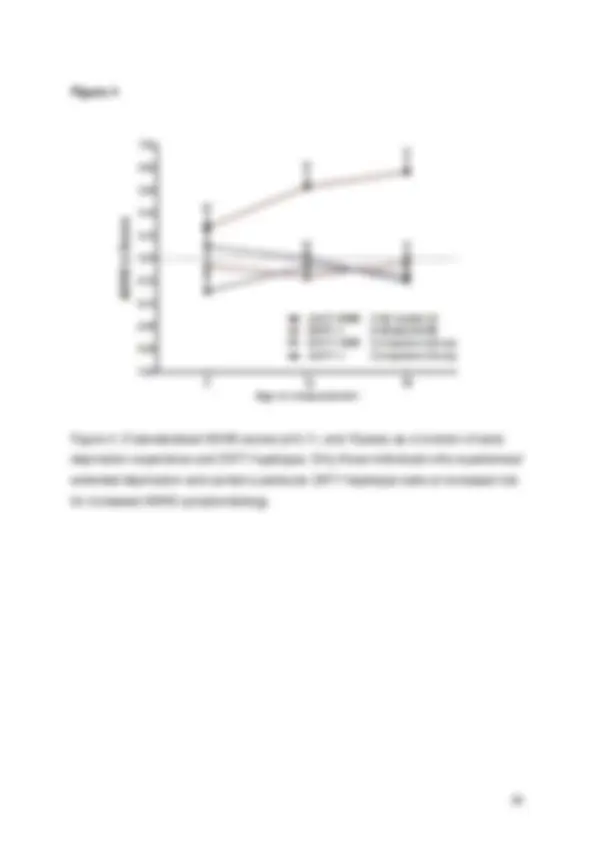


Study with the several resources on Docsity

Earn points by helping other students or get them with a premium plan


Prepare for your exams
Study with the several resources on Docsity

Earn points to download
Earn points by helping other students or get them with a premium plan
Community
Ask the community for help and clear up your study doubts
Discover the best universities in your country according to Docsity users
Free resources
Download our free guides on studying techniques, anxiety management strategies, and thesis advice from Docsity tutors
An overview of studies examining the relationship between early childhood adversity, specifically institutional deprivation, and psychological and behavioral development. the findings of various studies, including the identification of specific patterns of emotional and behavioral problems, such as disinhibited social engagement disorder (DSE), cognitive impairment, inattention/overactivity, and quasi-autism. The document also explores the persistence of these patterns over time and their association with neurobiological alterations.
What you will learn
Typology: Lecture notes
1 / 31

This page cannot be seen from the preview
Don't miss anything!
























Psychological consequences of early global deprivation: An overview of findings from the English & Romanian Adoptees Study
Robert Kumsta^1 , Jana Kreppner^2 , Mark Kennedy^2 , Nicky Knights^2 , Michael Rutter^3 , Edmund Sonuga- Barke2,
(^1) Department of Genetic Psychology, Faculty of Psychology, Ruhr-University Bochum, Germany (^2) Institute for Disorders of Impulse and Attention, Psychology, University of Southampton, UK (^3) MRC Social, Genetic and Developmental Psychiatry Centre, Institute of Psychiatry, King’s College London, UK (^4) Department of Experimental Clinical and Health Psychology, Ghent University, Ghent, Belgium
Correspondence to Prof. Edmund Sonuga-Barke Psychology - Shackleton Building (B44) University of Southampton Highfield Campus Southampton SO17 1BJ Phone: +44 (0)2380 594604 Fax: +44 (0)
Funding sources : The current study is supported by ESRC grant ES/I037970/1 and MRC grant MR/K022474/1 to Edmund Sonuga-Barke. The various precursory studies have been funded by a number of organizations. The ERA study team is very grateful to all these organizations for this funding. The funding bodies for the ERA team have been: Department of Health (NIHR-CCF), Economic and Social Research Council, German Academy of Sciences Leopoldina, Helmut Horten Foundation, Jacobs Foundation, Janssen-Cilag, Nuffield Foundation, Medical Research Council, SLaM NHS Trust, UCB Pharamaceuticals Ltd.
Disclosures : In the last three years Professor Sonuga-Barke has received speaker fees from Janssen Cilag, Shire, Medice and QBtech and consultancy, grant funding, advisory board fees and conference support from Shire. All other authors declare no conflicts of interest.
Abstract
The English & Romanian Adoptees (ERA) study follows children who spent their first years of life in extremely depriving Romanian institutions before they were adopted by families in the UK. The ERA study constitutes a “natural experiment” that allows the examination of the effects of radical environmental change from a profoundly depriving institution environment to an adoptive family home. The cohort has been assessed at ages 4, 6, 11 and 15 years, and has provided seminal insights into the effect of early global deprivation. The current paper focuses on the long-term psychological sequelae associated with deprivation experiences. These deprivation specific problems (DSP) constitute a striking pattern of behavioural impairments, in its core characterized by deficits in social cognition and behaviour, as well as quasi- autistic features, often accompanied by cognitive impairment and symptoms of ADHD. Possible moderating influences, including variations in family environment, pre-adoption characteristics, and genetic variation, will be discussed to answer the question why some individuals have prospered while others have struggled. Apart from findings on the moderating effect of variation in genes associated with serotonergic and dopaminergic signalling involving specific phenotypes, heterogeneity in outcome is largely unexplained. The review will conclude with an outlook on currently ongoing and future research of the ERA study cohort, which involves the investigation of neurobiological and epigenetic mechanisms as possible mediators of the long-term effects of institutional deprivation.
Key words : Institutional deprivation, Deprivation specific patterns, Romanian adoptees, early adversity
have struggled. The review will conclude with an outlook on currently on-going and future research of the ERA study cohort.
Historical Context After the fall of the Ceaușescu regime in December 1989, there were around 142. children in Romanian institutions. The high demand for institutional child care was due to a number of social and economic factors. The severe economic conditions which existed for many families combined with the governments drive to increase Romania's population led to an increase in the number of unwanted and abandoned children. This was compounded by the accelerated industrialization and the increased levels of rural to urban migration and the destruction of extended families and rural community life. Furthermore, there was a tendency to refer children inappropriately to institutions if there was any doubt about their welfare in the home environment. The economic crisis also affected the institutions, creating shortages of food, equipment, drugs and supplies. With few exceptions, the conditions in the approximately 700 institutions varied from poor to appalling. They were organized like hospital wards with rows of cots in a large room. In most instances, the children remained alone, and were rarely taken out of cots. There were few, if any, toys or play things; very little talk from caregivers; no personalized caregiving; feeding of gruel by bottles with large teats, often left propped up; an environment that was frequently physically harsh. Staff was underpaid and not properly trained, with a staff to child ratio of about 1:30 (Children’s Health Care Collaborative Group, 1992).
”Natural Experimental“ Design The fall of the communist government was followed by widespread media coverage of the plight of the children being reared in these institutions. What followed was a humanitarian response that involved a substantial number of children being adopted. The situation posed both policy issues and theoretical challenges. From the scientific perspective, it was clear from the outset that the circumstances provided the basis for a potentially unique ‘‘natural experiment’’ for the study of the effects of early adversity of humans. Several important features of the situation contributed to this. There was a major discontinuity between the unusually extreme degree of deprivation in the institutions, and the typically above average rearing conditions in the adoptive homes in the UK to which they moved. The transition took place over a short period of time
and could be accurately dated. Importantly, the children were either born in an institution or moved into one within the early weeks of life. That meant that, unlike almost all previous studies of effects of institutional care, the children were extremely unlikely to have been placed in the institution because of pre-existing handicap. Furthermore, prior to the fall of the Ceauşescu regime, children in institutions had not been adopted and scarcely any returned to their biological families. Accordingly, there was no selection in terms of child characteristics with respect to which children had remained in or entered the institution. Lastly, the Romanian authorities often decided which children could be considered for adoption, thus reducing the possibilities of selective parental choice (Rutter, Sonuga-Barke, & Castle, 2010). The ERA sample was drawn from the 324 children adopted from Romania into families resident in England between 1990 and 1992. All included adoptions were dealt with through the appropriate UK legal channels. In order to examine possible effects of duration of institutional care, an age-stratified random sampling design was employed within the range of 0 to 42 months of age for UK entry. The Romanian sample consisted of 144 institution-reared children and 21 children from a very deprived background who had not experienced institutional care. In order to focus on the long-term effects of depriving institutional care, and in order to control for any effects of adoption, the comparison group were 52 children adopted within the UK who had not experienced institutional care or other known forms of severe abuse or neglect, and who were adopted before the age of 6 months. Assessments were undertaken at ages 4, 6, 11 and 15 years (currently, assessment of the now young adults is under way, see below). The longitudinal design enables us to study within- individual change over time, and the range of ages up to which institutional care continued enabled possible does-response effects to be examined – a crucial aspect of the study design when considering the ability to draw causal inference with regard to deprivation effects. The retention rate in the ERA study has been extremely high with data available for over 90% of adolescents at age 15 (Rutter, Sonuga-Barke, Beckett, et al., 2010).
In the ERA study, a wealth of data has been collected via interviews and questionnaires from both adoptees and parents, and by means of neuropsychological testing measuring the adoptees cognitive functioning and social cognition. The findings up to the age of 15 years were brought together and reported in detail in a
adversity of all kinds tended to be non-specific in terms of diagnostic patterns (McMahon, Grant, Compas, Thurm, & Ey, 2003). Common types of conduct and behavioural problems had often emerged by adolescence but these were typically only in those with pre-existing deprivation specific problems (Sonuga-Barke, Schlotz, & Kreppner, 2010). Other studies also have noted one or more of these patterns in post- institutionalised children (Behen, Helder, Rothermel, Solomon, & Chugani, 2008; Bruce, Tarullo, & Gunnar, 2009; Chisholm, 1998; Chisholm, Carter, Ames, & Morison, 1995; Ghera et al., 2009; Gunnar, Van Dulmen, & Team, 2007; Hoksbergen, ter Laak, Rijk, van Dijkum, & Stoutjesdijk, 2005; Kaler & Freeman, 1994; MacLean, 2003; Nelson et al., 2007; van Ijzendoorn, Juffer, & Poelhuis, 2005; van Ijzendoorn, Luijk, & Juffer, 2008; Zeanah & Smyke, 2008; Zeanah, Smyke, Koga, & Carlson, 2005), Specifically, considerable agreement exists across studies that a pattern of disinhibited social engagement constitutes a sequelae of prolonged institutional rearing and that this pattern is relatively stable over time and shows little responsiveness to intervention (Bakermans-Kranenburg et al., 2011; Smyke et al., 2012). Several studies also report difficulties with attention (Audet & Le Mare, 2011; Hodges & Tizard, 1989; McLaughlin et al., 2013) and cognitive delay (van Ijzendoorn et al., 2008). Few studies other than our own reported quasi-autistic features as a sequelae of institutional deprivation (Hoksbergen et al., 2005) although stereotypic behaviors have been reported by some (Bos, Zeanah, Smyke, Fox, & Nelson, 2010; Fisher, Ames, Chisholm, & Savoie, 1997). This is likely due to other studies not employing a systematic approach to measuring psychopathology and our sample being quite unique in the severeity of deprivation experienced involving substantial lack of nutrition, physical and health care, and emotional, social and cognitive stimulation. Importantly, few tested the specificity or followed up the developmental course of these impairments. We provided the first account that examined the effects over a long time span following adoption, and tested whether these four patterns can be considered as deprivation-specific. Furthermore, it was considered whether or not the four postulated deprivation-specific patterns (DSP) constitute a meaningful syndrome.
„ The concept of DSP is of a pattern that constitutes a distinctive early- appearing response to institutional deprivation that is rarely found in
other groups, that is likely to involve an enduring biological effect, and that is not eradicated by post-adoption experiences. “ (Rutter, Sonuga- Barke, Beckett, et al., 2010)
Seven criteria were set forth in order to examine DSP. First, the pattern must have been present at age 6 or earlier. Second, the pattern must have been distinctive in a way that differentiated it from the much more common emotional and behavioural disturbances of early childhood. Third, it had to be much more common in children whose institutional deprivation lasted to age 6 months or older. In earlier ERA papers, a linear dose-response relationship was described by which the risk of DSP increased the longer the time an individual spent in the institutions (Rutter, 1998). Subsequent analyses demonstrated a step wise relationship by showing that at age 11, the difference lay between institutional deprivation that did not continue beyond the age of 6 months and institutional deprivation that persisted longer than that (Kreppner et al., 2007). Accordingly, for the current analyses the focus was only on the comparision between those individuals experiencing more or less than 6 months deprivation. Fourth, the DSP must be rare in groups of children who had not experienced institutional deprivation. To examine this question, the groups who had experienced institutional deprivation for less than 6 months, those children adopted from Romania who had experienced deprivation only in family settings, and the children who were adopted within the UK, were combined. Fifth, there was the criterion that the postulated DSP should persist to age 11 and should continue to show a strong association with institutional deprivation at that age. Sixth, the postulated DSP must be accompanied by substantial functional impairment. Finally, we required that the postulated DSP should, at the level of the group as whole, be a consequence of psychosocial deprivation even when it was not accompanied by sub- nutrition (Rutter, Kumsta, Schlotz, & Sonuga-Barke, 2012; Sonuga-Barke et al., 2008). In other words, we wanted to concentrate on psychosocial deprivation and not simply nutritional lack.
The four deprivation specific patterns Quasi-autism (QA) QA referred to a pattern that showed autistic-like features (particularly, abnormal preoccupations and intense circumscribed interests) but which differed from “ordinary” autism in important ways (see also Table 1). Firstly, the pattern was
experienced prolonged institutional deprivation (39.1%) compared with the rate observed in the pooled comparison sample (7%, Kumsta, Kreppner, et al., 2010). In addition, there was substantial continuity of the DSE pattern up to age 15 with 66% of all DSE cases continuing to show the pattern at age 15. Importantly, by age 15, for most of the cases in the pooled comparison sample the pattern had faded whereas for nearly all the cases in the prolonged institution reared sample the pattern persisted over time into adolescence. Finally, using service usage as an index of functional impairment, the children with DSE had a significantly higher rate of service usage than those without DSE (56.8% versus 18.4%, Kumsta, Kreppner, et al., 2010). Moreover, within the >6 months institutionally deprived sample, 19/36 children were seen by M.R. for a detailed clinically assessment which confirmed the presence of substantial functional impairment.
On the basis of these data we proposed that QA and DSE should be seen as the distinctive and defining features of the core DSP construct. In contrast, as shown below IO and CI were far less distinctive in their expression and more typical in their associations with non-DSP elements. As a result they were defined as DSP at the individual level partly because of their overlap with DSE and QA. In other words CI and IO that did not overlap with DSE/QA were not seen as DSPs.
Inattention/overactivity (IO) In contrast to DSE and QA, it was less clear to determine whether IO constituted a distinctive pattern that was specific to children who had experienced institutional deprivation and was unusual in the broader population. Our findings across the different ages showed significantly higher rates of IO in the children who were adopted at 6 months of age or older (Kreppner, O'Connor, & Rutter, 2001; Stevens et al., 2008). As such it was important to determine whether there was a variety of IO which was a function of institutional deprivation which could be distinguished from ADHD in non-deprived samples. Indeed the prevalence of ADHD among the affected adoptees was very high compared to both the comparison group and the general population (Stevens et al., 2008). In terms of distinguishing this pattern from non- deprivation related ADHD there were two issues of significance. The first relates to differences in the clinical presentation, correlates and underlying neuro-biology; the second to differences in severity and establishing thresholds. Indeed the clinical
pattern in the affected group shared many features with Attention Deficit/Hyperactivity Disorder (ADHD) and the clinical diagnosis of ADHD was far higher in the over 6 month group than either the comparison group or the general population (16% had a CAPA diagnosis and 11% had received ADHD medication treatments at some point prior to adolescence; Stevens et al. 2009). In a direct comparison of individuals with ADHD in the ERA sample and a non-deprived clinical sample it was found that while ERA ADHD individuals shared a similar symptom profile to non-deprived individuals with ADHD there were also some interesting differences (Sonuga-Barke & Rubia, 2008). First, neuro-cognitive impairment was more severe in the institutionally deprived group. Second, comorbid conduct problems were far higher in the non-deprived sample although the same types of neuropsychological deficits were present. Finally, the normal sex bias with boys being at higher risk was not present in the deprived sample. Interestingly we have also found some initial evidence of common neurobiological mediators of deprivation and deprivation related ADHD. First, the risk for ADHD as a function of duration of deprivation is moderated by variation of the dopamine transporter gene (Stevens et al., 2009). Second, a small sub-group of institutionally deprived children from the ERA sample show diminished striatal activation to reward cues (Mehta et al., 2010). Together the findings provide initial evidence implicating dopamine dysregulation in deprivation related ADHD – which if true would suggest some common neurobiological elements to ADHD irrespective of whether it emerged following deprivation or not.
Cognitive impairment Similar to IO, a key concern was to determine whether it constituted a pattern that was a function of institutional deprivation as distinct from the usual varieties of cognitive impairment. As with IO, observation of the distribution of IQ scores suggested that the cut-off of 74 we applied in previous papers (Beckett et al., 2006) was probably too stringent. The distribution of IQ scores at age 6 (as indexed by the general cognitive index of the McCarthy Scales) suggested that the effects of institutional deprivation extended much more widely. There was not just an extreme group that scored in the very low range but the entire distribution was shifted towards the left in the >6 month institutionally deprived group (see Figure 3.3, p.61 in Kumsta, Kreppner et al., 2010). As with IO, even when the bottom extreme group (i.e. 33rd
multivariate analyses, we conducted additional analyses that were restricted to the subsample who suffered no significant overall subnutrition as indexed by their body weight at the time of leaving the institution (Rutter et al., 2012; Sonuga-Barke et al., 2008). To ensure our statements were conservative we set a relatively low threshold for defining sub-nutrition. In the absence of more direct measures or specific physiological markers of nutritional status during the period of institutionalization, the definition of subnutrition was based on measures of weight standardized in relation to UK norms. Subnourishment was indexed by a body weight at the time of leaving the institution that was below 1.5 standard deviation limit in relation to U.K. population norms. Results showed that extended institutional deprivation (>6months) in the ‘pure’ psychosocial deprivation group (i.e. absence of subnutrition) had a major effect in leading to DSP. Furthermore, this subgroup was characterized by substantial developmental delay at entry to the UK as indexed by the Denver developmental quotient, and IQ scores about one standard deviation below the population at all assessment ages (6, 11 and 15 years). Lastly, we observed a very large decrease in head size in the ‘pure’ psychosocial deprivation group (Figure 2). The observation that severe deprivation in the absence of subnutrition can lead to psychological sequelae and produce fundamental alterations in head size, and by extrapolation, brain size, reinforces the view that psychosocial deprivation appears to have a pervasive effect across biological and psychological systems, independent of the nutritional risk often associated with institutional deprivation (Rutter et al., 2012).
Emotion, Conduct and Peer Problems Following Early Deprivation As mentioned above, somewhat surprisingly, the usual types of psychopathology typically associated with early adversity, i.e., emotional problems (MacLean, 2003), conduct problems (Juffer & van IJzendoorn, 2005) and problems with peers (Gunnar et al., 2007) did not constitute an aspect of the mental health problem profile of the deprivation adoptees in the ERA sample at 6 years (Rutter, Kreppner, & O´Conner, 2001). With the available data at 15 years, we systematically examined the growth curve trajectories of emotional problems, conduct problems and peer problems and their associations with DSPs (Sonuga-Barke et al., 2010). The results of the analyses at age 15 years showed the important role of DSPs in driving the emergence of common emotional and behavioural problems in the sample and also presence of distinct patterns of association between DSPs and
conduct problems, emotional problems and peer problems. At the group level, conduct problems were significantly elevated at all ages in the Romanian adoptees and were associated with IO. By contrast, the >6 month group had elevated levels of emotional problems by 11 years and this difference was accentuated by 15 years. This effect was most pronounced in the group with DSPs. In addition, the DSP presence mediated the association between length of institutionalisation and emotional problems. Furthermore, the adolescent onset of emotional problems was associated with all four types of DSP and manifested as mainly depressive-type emotional problems, but not anxiety. The effect of peer problems was different again and combined the effects of conduct and emotional problems, suggesting a general, negative outcome of both more specific conditions as well as DSP presence more generally.
Genetic and environmental factors that moderate the negative effects of adversity There is extensive evidence of huge heterogeneity in the response of individuals to all environmental hazards, both physical and psychosocial. This is also true for the effects of the extreme early adversity as experienced by the Romanian adoptees. All research into institutional deprivation, including our own, has shown the marked heterogeneity of effects both in terms of severity of outcomes and in terms of the profile of problems. Accordingly, it is necessary to consider what influences might account for this heterogeneity. For instance, as indicated above, about half of the children in the over six months group did not show impairments despite having spent up to 3 1/2 years in extremely depriving conditions. Several moderating factors could potentially account for this heterogeneity.
Pre-adoption characteristics Several pre-adoption features were tested for moderation effects. Birth weight or body size at birth are commonly used as markers of the fetal environment and provide a limited index of unfavourable environments during pregnancy. Other than birthweight, only very limited data were available on peri- or prenatal circumstances in the ERA sample. The analyses showed that birthweight was completely unrelated to the emergence of DSPs. It was further analysed whether severity of intellectual impairment and stunted physical development at the time of leaving institutional care
apply to many medical conditions and psychological disorders as well as psychopathology (Rutter, 2008). Our analysis so far has published on two putative functional polymorphisms in two genes both previously shown to (i) affect susceptibility to environmental risk (Caspi & Moffitt, 2006) and (ii) implicated in relevant clinical outcomes. It is important to note that these analyses concern two specific phenotypic outcomes associated with psychosocial deprivation, but not DSP as a whole.
Serotonin transporter gene and depression Transcriptional activity of the human 5-HTT gene ( SLC6A4 ), a key regulator of serotonergic neurotransmission, is influenced by genetic variation (Murphy, Lerner, Rudnick, & Lesch, 2004). The short allele (s) of a common length polymorphism (Lesch et al., 1996) has been associated with numerous anxiety and depression- related phenotypes (Canli & Lesch, 2007). More importantly, the 5-HTT promoter polymorphism has repeatedly been shown to moderate the effect of adverse life experiences on the risk of depression in children, adolescents and young adults (see Karg, Burmeister, Shedden, & Sen, 2011) for meta-analysis). The majority of these studies did not follow-up after objectively recorded adversity, and investigations on gene–environment interaction studying early adversity often have the limitation of relying on retrospective reports of environmental events (Uher, 2008). This led us to investigate the moderating role of the 5HTTLPR in the effects of institutional deprivation on emotional problems in the ERA study. Emotional problems were assessed using questionnaire data (age 11), and on the basis of the Child and Adolescent Psychiatric (CAPA) diagnostic interview (age 15). Additionally, the number of stressful life events was measured. We found a significant effect for genotype and a gene x environment interaction that was independent of age at testing. As shown in Figure 3, carriers of the s/l and s/s genotype who experienced severe institutional deprivation showed the highest emotional problem scores, while l/l homozygotes in the severe institutionally deprived group showed the lowest overall levels.
The Dopamine transporter gene and ADHD Molecular genetic research of ADHD points towards the dopamine transporter gene as a suitable candidate for an investigation of GxE interaction in relation to
symptoms of ADHD in the ERA sample. Much of the research of the genetics of ADHD has focussed on a polymorphism within the dopamine transporter (DAT1) gene, which codes for a protein that regulates the reuptake of dopamine at the presynaptic level. The studies of the human DAT1 gene ( SLC6A3 ) have focused on a common repeat polymorphism within the 3’untranslated regionof the gene (Cook et al., 1995; Pliszka, 2005; Thapar, O'Donovan, & Owen, 2005) In the ERA study, we investigated whether the DAT1 10R-6R haplotype moderated the risk for ADHD following extended institutional deprivation (Stevens et al., 2009). Symptoms of ADHD were measured at ages 6, 11 and 15 years. There was significant GxE interaction across the study period between institutional deprivation experience and DAT1 haplotype and a three way interaction with assessment age (see Figure 4). This indicated that the children who were exposed to institutional deprivation lasting 6 months or more and possessed the DAT1 10R-6R haplotype had higher ADHD symptom scores, with the GxE interaction effect becoming stronger as the children entered adolescence. Moreover, a similar pattern of effects was found across measures of ADHD when the children were 15 years of age. These results confirmed the potential of DAT1 polymorphisms to moderate the effects of early adversity associated with institutional deprivation on symptoms of ADHD.
Taken together, evidence on the role of selected genetic polymorphism in moderating outcome heterogeneity following early deprivation adds new important aspects to the field of gene-environment interactions research. Importantly, the ERA study followed- up individuals after objectively reported trauma, ruling out recall bias. Furthermore, the major discontinuity between an appalling degree of deprivation in the Romanian institutions in which the children spent their early life, and the somewhat above average rearing conditions in the adoptive homes in the UK to which they moved, rules out the possibility of continuing adversity underlying the observed effects. By utilising data on ADHD symptoms and symptoms of depression available from childhood to mid-adolescence we were able to investigate the longitudinal pattern of GxE interaction between risk factors over time. This investigation provided evidence for longitudinal emergence and continuity in GxE effects across childhood and adolescence.
On-going study in Young Adulthood
disability with presence of strong family history of both epilepsy and learning difficulties. Subnutrition was also considered as a relevant factor, and we demonstrated that psychosocial deprivation has a pervasive effect independent of the nutritional risk often associated with institutional living (Sonuga-Barke et al., 2008). It has to be acknowledged, however, that body weight (our index of subnutrition) is only a crude indicator of nutritional status. No measurement was available on the balance of the diet or specific nutritional deficiencies in the institution. Accordingly, it remains possible that malnutrition (rather than subnutrition) could have potentiated the ill effects of psychosocial deprivation. The next question is whether the effects might be a consequence of experiences before, rather than during, institutional care. Birth weight, body size at birth, gestational age or indices of the former are commonly used as markers of the fetal environment. As a limitation, it must be noted that other than birthweight, no reliable and systematic data were available on peri- or prenatal circumstances in the ERA sample. However, low birth weight was a very weak predictor of outcomes in the total sample. The most convincing evidence against a prenatal effect was the strength of the 6-month cut-off for depriving institutional care. There is no plausible way that that could be accounted for by prenatal risk factors, identified or nonidentified.
Generalization of DSPs to Other Populations We do not know whether our findings generalize to other populations of young people. Two important issues on generalization of these findings have yet to be resolved. First, research is needed to determine which aspects of DSPs may be found in association with abuse or neglect as it occurs in families rather than in institutional contexts. Second, research is needed to determine which aspects of DSP are specific to institutional deprivation and which are a consequence of rearing in institutions that lack personalized caregiving, but which does not involve pervasive, gross deprivation that applied to Romanian institutions of the Ceausescu regime. A crucial requirement with respect to both of these research needs is to use measures that can tap both the Q-A features and DSE patterns. Regarding quasi-autism, the use of well validated screening instruments such as the Social Communication Questionnaire (Rutter, Bailey, et al., 2003) or the Social Responsiveness Scale
(Constantino et al., 2004) might be reasonable alternatives to the labour intensive ADI-R and ADOS interviews. There is no generally accepted, and well tested, measure of DSE, and we found that a combination of parent report and investigator ratings worked best. Others have shown that the most commonly used parent report measures of indiscriminate behavior were largely convergent (Zeanah, Smyke, & Dumitrescu, 2002), and that a behavioral measure substantially converged with parent report (Gleason et al., 2011).
Conclusion In summary, the ERA study has provided seminal insights into the impact of early institutional deprivation, as an extreme form of adversity, on development. In bringing together the findings of the ERA study up to age 15 years, we addressed the question of whether there are DSPs that differ meaningfully from other forms of psychopathology. We observed a specific pattern of impairments, characterized by deficits in social cognition and behaviour, as well as quasi-autistic features, often accompanied by cognitive impairment and symptoms of ADHD. This pattern was early appearing, rarely found in our control group (comprised of within UK adoptees, non-institutionalized Romanian children, and Romanian adoptees who had experienced institutional care which had ceased before the age of 6 months), and showed substantial stability over time. We conclude that the ERA findings have provided good evidence that institutional deprivation does truly cause deprivation- specific psychological patterns and these effects are unlikely to be caused only by nutritional factors or infection. The observation that these effects persisted over a long term follow up despite predominantly positive post-adoption experience points towards effects which appear to be grounded in neurobiological processes and alterations. On-going research on these biological processes and factors is expected to provide a more complete picture across a longer period of time. From a methodological perspective the ERA study highlights the power of longitudinal natural experiment designs to study environmental effects, their mediators and moderators, in this case providing powerful evidence of a causal effect of ‘pure’ psychosocial deprivation on the liability to DSP. From a scientific perspective, the complex interplay between heterogeneity and specificity of adversity effects has been particularly striking. We have observed